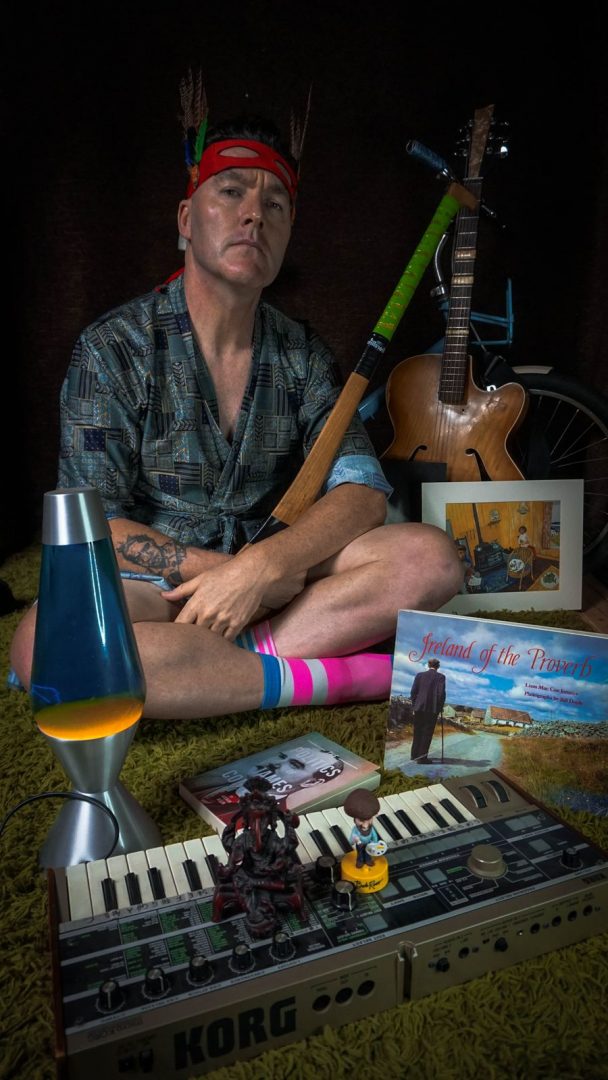Socialist, podcaster and Bonneville Andy McGibbon didn’t let the grass grow under his feet during six months of lockdown. While most of us were either baking banana bread and getting fat or training for the next 5K, Andy got down to recording his first solo project – the eleven-track wonder that is 'Northern Gothic'. By his own admission, this won’t appeal to all hardcore, blues punk Bonnevilles fans – but it’ll appeal to enough, and if you ask me, may well glean for him a whole new fanbase.
Ask me to define this album in terms of genre and I’d be stumped! It’s trippy, it’s synthy and sublime. It’s certainly got Andy’s inimitable vocal styling. I’ve often said, you’ll never hear Andy sing and mistake him for anyone else – but it’s hard to pigeonhole. So rather than try, I spoke to Andy (from a safe distance) to get his take on it. In reality, this was a passion project, written without rules and with no desire to please anyone but himself:
I don’t want to sound too wanky, but I wanted to make art and I think I’ve done that, even down to the sleeve design and the videos.
He’s not wrong – it’s a nice looking thing. From the striking black and white photograph of some his nieces on the front which could be a still from a kitchen sink drama, to the hilariously surreal portrait of Andy in weird sensei garb on the back, this album is a treat for the eyes as well as the ears!
In the Bonnevilles, Andy cited Robert Johnson and Otis Redding among his influences. Here he leans on a whole different kind of inspiration, ranging from Flann O’Brien to the birds in his own back yard. He explained the unusual process he developed of making little 5-7 second cassette tape loops of sounds then trying to hear the melody or beat in that sound, and building the songs from there:
Being free enough creatively to go with whatever the universe gifts you in that moment.
His idea was not to sit down with a guitar and write as he normally does, he wanted this album to come from a completely new place – and he’s certainly achieved that. On first listen, I felt sure that there was a whole raft of musicians on this record, and I imagined a complicated process of remote recording and rehearsals via Zoom. Not so, it transpires. It is a solo album in every sense of the word.
I recorded everything myself. That was a huge part of the challenge. I even built the studio for the project. When I think back it is quite daunting but sure if it was easy everyone would be doing it.
The main thing to distinguish this album from Andy’s Bonneville’s projects is its synth sound. I wondered if this was something Andy had always fancied turning his hand to.
Yeah, I love synths, I love cinema soundtracks. Bladerunner was a huge part of my musical landscape so when I got the chance to use these awesome synths, I jumped on it.
The result is a hugely interesting sound that seems wholly original.
The opening track ‘We’ve Hot Horns’ would be worth checking out if only for the madcap video alone! The riotously bonkers Micky Bartlett embarks on death-defying feats of extreme roller-skating while leaping over flaming ramps. Adding a much-needed touch of class to proceedings is Andy’s wife, the beautiful Janie. The video is a right laugh but shouldn’t detract from the fact that the song is great – and has something important to say! A spoken word portion is from an American political figure from the 1920s called Huey P. Long, a notorious socialist preaching in the deep south about the evils of capitalism, which ultimately ended up costing him his life. It’s not hard to see why his words resonated with Andy.
The album features another completely spoken word track: ‘An Analogue. A Treatise on Violence’. During lockdown Andy broadcast several podcasts, airing his views on matters political, social, and philosophical. I wondered if this track had been lifted from there, but no. It’s a candid stream of consciousness on the evils of capitalism which, Andy explained, he’d edited to fit the song. It’s a powerful thing.
The remaining tracks on the album are heterogeneous, to say the least. The pretty little ‘Caoineadh Lim’ is perhaps closest to the guitar centred Bonnevillian sound. About as different to that you can imagine is the static white noise of ‘Crime Scene’, redolent of humming morgue freezers.
Dedicated to one of his two daughters, ‘Summer’s First Tattoo’ is a hauntingly atmospheric instrumental piece, showcasing Andy’s signature guitar style. The album’s title track enthralls with its sound effects, distorted opening, and Andy’s distant, subaquatic sounding vocals. And did I mention the album is vaguely weird? I think I did. For proof, look no further than the throbbing, tribal drumming, the curious, hypnotic chant of ‘Johnny Weismuller’s Lagoon’. At the moment that’s the one on repeat in my car.
In its elements, ‘Northern Gothic’ is in turn stirring, thought-provoking, twinkling. As a whole it’s a stained-glass window of colour and sound. The prevailing “feel” is raw, it’s affecting and that’s no accident. Andy told me:
I do like that raw feel to a record. I like to hear the room in a song if possible.
He acknowledges that that can be a turn off for some listeners who like their artists to have the more polished finish that a lot of music seems to have these days.
But the reality is there would be no other way to make this record other than how I did it.
Learning as he went along in terms of writing, recording, and producing his album all by himself, the finished product is quite the accomplishment.
